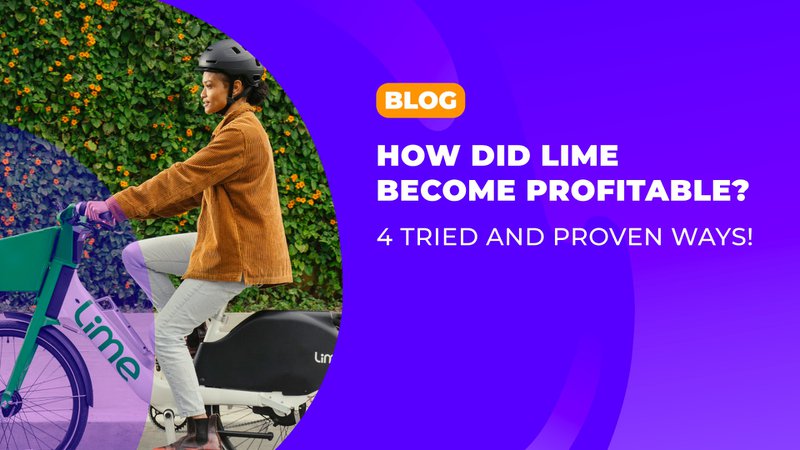How did Lime become profitable? 4 tried and proven ways!
The race to turn a profit is on – and the winner is Lime! In 2022, Lime became the first micromobility operator to report a profitable year. In this article, we showed how the key to sustainable growth is to maximize rides per customer. For Lime, mobility gamification is what’s driving their customers to ride. So don’t delay, the time to gamify is now!

Let’s find out how the Lime gamification & loyalty features helped them become the world’s first micromobility app to turn a profit.
- How Lime uses mobility gamification
- Why do companies like Lime use mobility gamification?
- 4 examples of gamification features available on Lime app
- The impact of the gamification & loyalty features available on Lime app
- How to increase profitability with StriveCloud
- FAQs
How Lime uses mobility gamification
You’ve probably heard of points systems, levels, and leaderboards. That’s because these are some of the most popular game mechanics in use today. And for good reason! When you use one or a combination of these game mechanics, you build a playful and addictive experience that hooks your customers in.
But Lime uses mobility gamification to do more than create a fun experience. In reality, gamified features can reward and drive the behaviors that support your business goals! For example, to maximize rides per customer. Naturally, Lime wants customers to ride more – that gets them more bang for their buck! Well, to drive your customers into action, you need a customer-centric approach. That’s what gamification offers!
The strategy has paid off – in Lime’s 2020 report, they revealed that customers are riding scooters longer and farther than before. As a result of growth like this, Lime hit a huge milestone – they became the first micromobility company to turn a profit! Even more impressive, Lime’s profit was $466 million, nearly double that of their biggest competitor, Bird!

Why do companies like Lime use mobility gamification?
Research shows how gamification taps into human psychology. In further detail, what makes gamification so powerful is that it plays on our common needs and desires. For example, here are just 3 ways gamification can help mobility operators:
1. Competitive elements motivate customers
Win or lose, competition is hugely motivating! For instance, you could let customers compete to win the top spot on a leaderboard. This competition leads to several benefits:
- Competing is a social activity and socialization boosts engagement
- Competitions can be used as a benchmark for growth, and this positively reinforces customer activity
- Creates goal-driven behavior, which encourages continued engagement
What’s more, researchers report that competition is so effective that customers are still motivated even when there’s no real-world prize!
2. Maximize trips per customer
It’s all about fun! In fact, studies find that a fun experience is what makes someone want to ride an e-scooter in the first place. Knowing this, you can see how gamification comes in useful! Essentially, gamification uses goals, rewards, and incentives to make the experience more enjoyable. In turn, this creates ‘intrinsic motivation’. In other words, your customer is more motivated to use your service simply because they enjoy it!
3. Reward customer loyalty
Put simply, give rewards for actions that you want to encourage. Of course, that includes loyalty! In fact, reports note that gamified loyalty programs are better at engagement. That’s because “traditional loyalty programs under-serve motivations like self-efficacy and self-expression.” In short, they don’t empower the customer!
Whilst traditional loyalty programs focus on extrinsic rewards like discounts and VIP experiences, the gamified Lime loyalty features rewards on a deeper, more intrinsic level. In essence, Lime’s rewards focus on human needs, such as progress and achievement. And when you fulfill these needs, you create value. In turn, this fosters loyalty! In practice, apps get a 22% rise in brand loyalty after introducing gamification!
4 examples of gamification features available on Lime app
Celebrating milestones
Milestones are a great marker of progress. In brief, they can be used to provide feedback and positive reinforcement. As a result, this motivates the rider! For example, when you finish your first ride with Lime, Lime congratulates you. All in all, this is an easy way to personalize the feedback and strengthen your relationship with the customer.

Gamified referral program
By far, the best way to create loyal customers is to use your existing ones! In fact, referred customers are 37% more likely to stick around! Given this, Lime gamification & loyalty features incentivize referrals. It does this by rewarding both parties with €3 in riding credit. And according to science, equal-split rewards are the best option.
Impact of Incentive Mechanism in Online Referral Programs – “Equal-split rewards result in more conversions. It increases the invitee’s likelihood to accept a referral, due to selective and better targeted referrals.”

Planting trees for pennies
50% of people ride e-scooters to reduce their emissions. Given this, Lime is smart to partner with the green fintech company Aspiration. Essentially, Lime riders with an Aspiration debit card can round up their spending to the nearest Euro. In turn, these pennies go towards planting trees!
What’s more, Aspiration users get 12 months of the LimePass for free! That’s a whopping 365 days of no unlock fees. This exclusive access recognizes and rewards Lime’s loyal customers. Not to mention, it satisfies the human need for a higher status.

Rewards for “Juicers”
To be sure, fleet rebalancing can be a huge headache for mobility operators. If your scooters aren’t charged, or they aren’t in the right location at the right time, then you are losing customers. But Lime found a solution! As a part of the Juicer program, people can sign up and get paid to charge Lime’s scooters.
As a result, this program sets off a positive feedback loop:
- Creates a community of loyal customers who care for Lime scooters.
- This results in better fleet rebalancing.
- Which improves availability and reliability, facilitating customer engagement!

The impact of the gamification & loyalty features available on Lime app
Thanks to mobility gamification, Lime has one of the best customer experiences in shared mobility. Take the Juicer program. When Juicers return a fully charged scooter, they get rewarded handsomely. Naturally, this incentivizes the Juicers to do a great job! And Lime’s CEO spells out just how important this is:
Toby Sun, CEO @Lime – “The Juicer program is very important for us to maintain a higher quality operation, so that people see less mis-parking, vandalism, or problematic scooters in the market versus our competitors… it’s very, very scalable and very, very efficient.”
Essentially, Juicers make Lime a more reliable mobility operator. As a result, Lime increases their customer engagement and loyalty! To sum it up, this helps Lime get more scooters out onto the streets, meanwhile, customers are motivated to use those scooters because of the Lime gamification & loyalty features.
And thanks to that improved unit economics, Lime results from 2022 are impressive:
- Rides up 20% year-on-year in every single quarter
- 1.5 million new riders (bringing the total to 4 million active riders)
- 33% increase in gross revenue
- 120 million trips taken, which comes to 4 rides every second in 2022
But the Lime gamification & loyalty features don’t stop there. Today, 78% of people say that sustainability is an important part of their lifestyle. That’s why Lime partnered with Aspiration to plant 5 million trees! No doubt, this partnership helps fuel Lime’s success. When companies become more sustainable, the boost to customer satisfaction is huge!

How to increase profitability with StriveCloud
The Lime gamification & loyalty features are specifically designed for their app and business goals. However, what works great for Lime might not work for you! Indeed, if you want to properly differentiate your service you need your own gamification strategy.
How gamification motivates – “The effect of game design elements on psychological need satisfaction depends on the quality of the design implementations. In other words, the whole process of implementing gamification plays a crucial role.”
In short, you can’t just copy Lime’s gamification & loyalty features! Instead, you need to understand how your audience thinks. What do they want? What rewards will motivate them? To guide you through this process, StriveCloud can help. On average, our clients see a 300% increase in trips booked by active customers!
Here’s how it works: we provide you with a range of gamification & loyalty features that you can customize. This way, you can make your customer experience truly unique and set yourself apart from other mobility operators! What’s more, getting started is easy. We have 3 simple steps to put you on your way to success:
- First, we kickstart our collaboration with a gamification workshop. During this, we’ll identify the best way forward given your goals and target audience.
- Second, we will set up our software to integrate the new features straight into your mobility app! What’s more, you’ll gain access to a central control panel that lets you make changes and interactions to the gamified experience live into your app.
- Finally, we have a personal approach to onboard and train your team to use our software, so you can work the way you want! Of course, our team will be there to help at every step.

